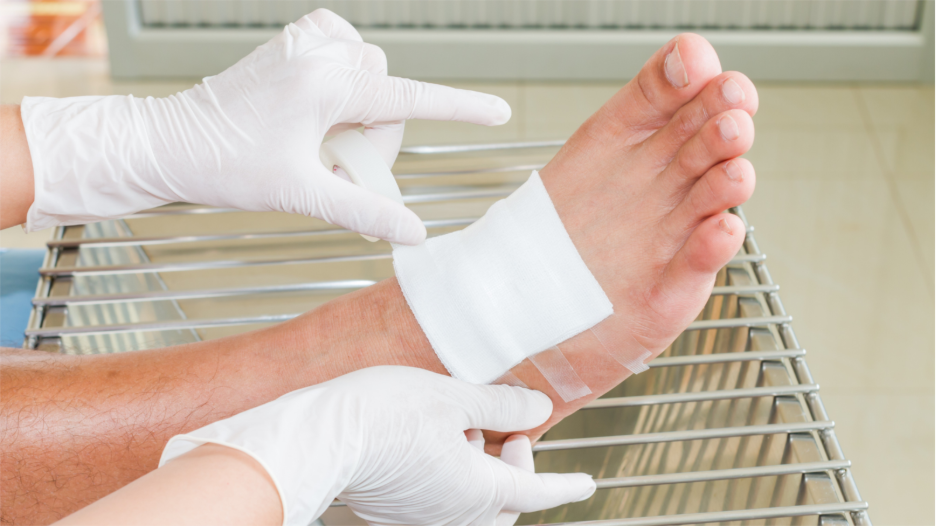Foot wounds may seem minor at first, but for individuals with diabetes, circulatory problems, or reduced mobility, they can quickly escalate into serious health issues. Even a small cut or blister can lead to infections, ulcers, and in extreme cases amputation if left untreated. That’s why proper foot wound care is not just recommended it’s essential.
In this article, we’ll explore everything you need to know about caring for foot wounds at home, when to seek professional help, and how to prevent future complications. Whether you’re managing your own foot health or caring for a loved one, this guide offers practical, step-by-step strategies that promote healing and protect long-term well-being.
Why Foot Wound Care Matters
The feet endure a constant cycle of pressure, friction, and exposure, making them highly susceptible to injury. For seniors, diabetics, or individuals with poor circulation, the risk is even higher. These groups often experience slower healing, reduced sensation, and diminished immune response all of which make wounds more dangerous.
Without effective foot wound care, complications may include:
- Infection that spreads to deeper tissue or the bloodstream
- Foot ulcers that become chronic and difficult to treat
- Tissue death (necrosis) requiring surgical intervention
- Amputation in severe cases of untreated diabetic wounds
Acting quickly and following a thorough wound care routine can drastically reduce these risks and improve outcomes.
Step-by-Step Guide to Proper Foot Wound Care
1. Clean the Wound Immediately and Carefully
Start by gently rinsing the wound with saline solution or lukewarm water to remove debris. Avoid harsh substances like hydrogen peroxide or alcohol, which can damage healthy tissue.
Steps to follow:
- Wash your hands thoroughly
- Use a sterile saline solution or mild soap and water
- Pat the area dry with clean gauze or a soft towel
- Do not scrub this can worsen the wound
2. Apply a Suitable Dressing
The dressing protects the wound from dirt, moisture, and bacteria. The right type of dressing depends on the size, depth, and amount of drainage from the wound.
Common options include:
- Hydrocolloid dressings for moisture balance
- Foam dressings for high-exudate wounds
- Antimicrobial dressings to prevent infection
- Non-adherent pads to reduce trauma during removal
Change dressings at least once a day or whenever it becomes damp or dirty.
3. Watch for Early Signs of Infection
Even with the best care, wounds can become infected. Monitor closely for the following red flags:
- Redness spreading from the wound
- Increased swelling or warmth around the area
- Pus or foul-smelling drainage
- Fever or chills
- Increased pain or discoloration
If you notice any of these symptoms, contact a podiatrist immediately.
4. Offload Pressure from the Wound
Pressure on a healing wound delays recovery and increases the risk of complications, especially in weight-bearing areas like the soles or heels.
Tips to relieve pressure:
- Wear cushioned or offloading footwear
- Use crutches or a walker if needed
- Limit walking and standing
- Consider specialized orthotic devices provided by a podiatrist
5. Seek Professional Help for Non-Healing Wounds
Some wounds especially in patients with diabetes require advanced treatment that goes beyond home care. If a wound hasn’t improved within a week, shows signs of infection, or exposes deeper tissue, it’s time to call in a professional.
A mobile foot doctor or podiatrist can offer services like:
- Debridement (removal of dead tissue)
- Prescription topical antibiotics
- Custom wound dressings
- Diabetic foot assessments
- Circulation and nerve testing

Preventing Foot Wounds Before They Start
Prevention is a vital part of foot wound care, especially for high-risk individuals. The best outcomes come from a proactive approach.
Daily prevention tips:
- Inspect feet every day for cuts, blisters, or redness
- Moisturize dry skin, avoiding lotion between toes
- Trim toenails carefully and regularly
- Wear breathable, well-fitted shoes
- Never walk barefoot especially outdoors or on hard surfaces
Patients with diabetes should also have routine foot exams with a podiatrist to catch problems early.
To dive deeper into diabetic foot prevention, check out our related article: Understanding Foot Ulcers: Stages, Causes, and Diabetic Foot Care
Why In-Home Wound Care May Be the Best Option
For seniors or individuals with mobility limitations, traveling to a clinic for regular wound checks can be difficult or even dangerous. That’s where mobile podiatry services come in.
A mobile foot doctor brings expert foot wound care directly to your home, providing:
- Personalized wound assessments
- Professional cleaning and dressing
- Diabetic foot exams
- Infection prevention
- Education on proper home care techniques
At Allevio Care Anywhere, we specialize in in-home foot care tailored to seniors, diabetics, and patients with chronic wounds. Our licensed podiatrists understand the unique needs of aging feet and offer compassionate care in the comfort of your home or care facility.
Final Thoughts: Don’t Wait — Your Feet Deserve Expert Care
Ignoring a foot wound no matter how small can have serious consequences. With consistent foot wound care, attention to warning signs, and support from a qualified podiatrist, you can reduce your risk of infection, promote faster healing, and protect your mobility and independence.
Whether you’re recovering from surgery, managing a chronic condition, or caring for an elderly loved one, expert foot care should never be out of reach.
Schedule your in-home podiatry visit today. Let Allevio Care Anywhere bring trusted foot care to your doorstep.
Key Takeaways:
- Proper foot wound care is crucial for preventing infection and promoting healing
- Daily cleaning, dressing changes, and monitoring are essential
- People with diabetes or circulation issues should seek early professional help
- In-home podiatry offers convenient, personalized care
- Proactive prevention is the best long-term strategy






